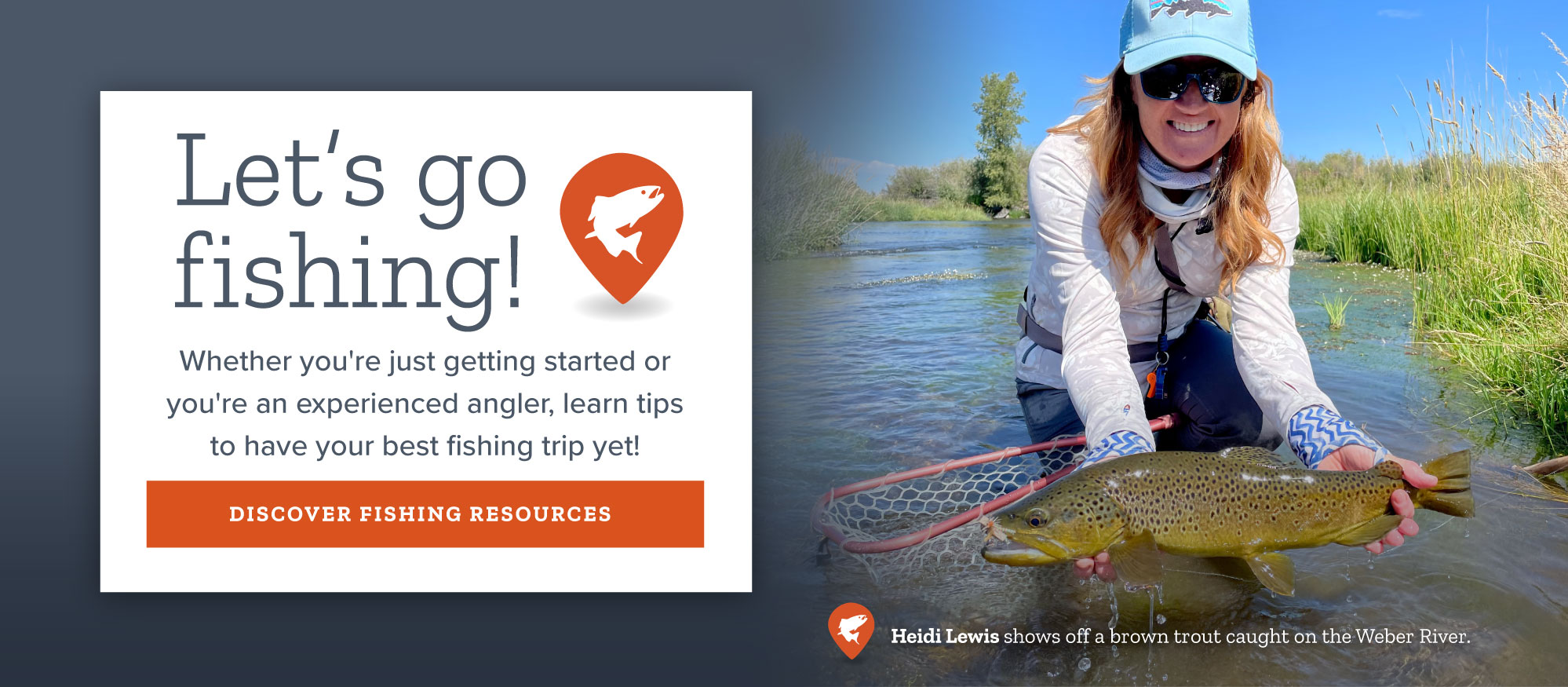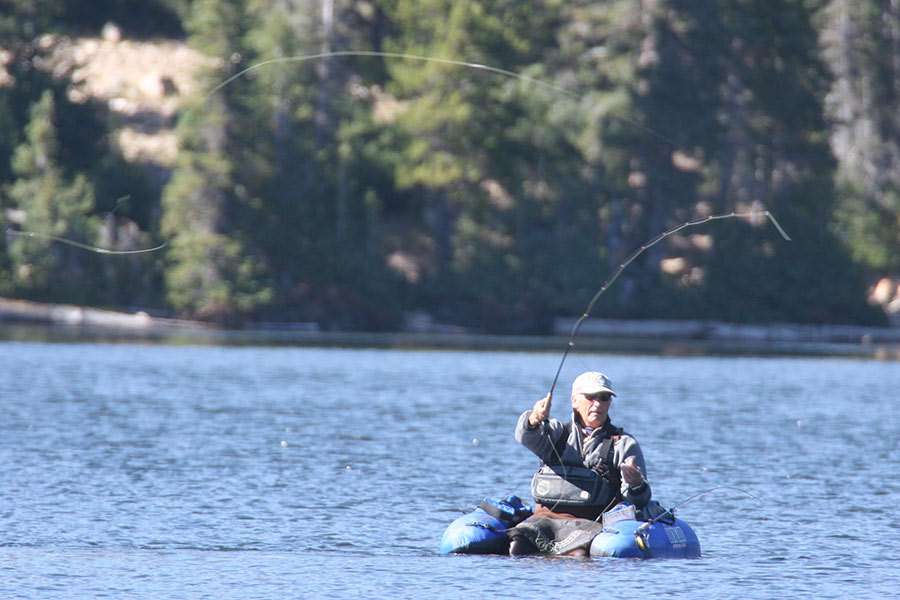Why high water shouldn't mean low expectations
What anglers can expect at Utah waterbodies this summer and in years to come
Randy Oplinger
DWR Sportfish Coordinator
After a winter of record-breaking snowfall, it's no surprise that we're seeing higher than normal flows at waters throughout the state. After years of ongoing drought, it's great to see water levels rising at our reservoirs and lakes.
Utahns are used to seeing our snowpack vary from year to year. These variations lead to fluctuations in water levels in our reservoirs, lakes, rivers and streams, which in turn impact the quality of fishing. Here's a summary of how we anticipate water levels — both high and low — impact fishing in Utah in the coming months and beyond.
This year's high water may mean slower fishing in lakes and reservoirs
Reservoir and lake water levels are higher this year than in past years, and this increased volume provides fish with more water to occupy. And, it provides more habitat for prey foods that fish rely on, like zooplankton and insects.
As a result of the current conditions, our prediction is that at some waterbodies fishing may be slower this year than in past years. That is because higher water levels allow fish to disperse more, making them more difficult for anglers to locate. Also, lots of natural prey and an abundance of other food sources may mean that fish bellies will be more full this year, making fish less inclined to take bait and lures.
But high water now means great fishing in the future at our lakes and reservoirs
There is a silver lining to this. The high water levels provide conditions that are prime for fish growth. This is because the high water levels provide more habitat for various fish prey items such as zooplankton and insects to grow. Also, the high flows bring in nutrients that help these prey items flourish.
This means that anglers should see larger fish, probably starting next year.
Also, conditions are great for high survival of fish populations. In addition to bumping up the availability of food sources, high water generally provides fish with more habitat. For example, higher water levels submerge brush that has grown along shorelines during drought years. For species like yellow perch, crappie, bluegill and bass, this submerged brush provides great spawning habitat and cover for newly hatched fish. Also, the sunken vegetation adds nutrients to the water as it decomposes, in turn increasing the production of zooplankton and invertebrates — favored food sources for many species of fish.
As a result of these conditions, we expect strong growth of many fish species in the years to come. Anglers may expect to see larger numbers of trout starting next year, and more yellow perch, crappie, bluegill and bass in two to four years. Also, the fish that anglers see should be a little larger than in recent years.
Let's go fishing
- See the Utah Fishing Guidebook (guía en español, Guía de pesca de Utah) for the state's fishing rules and regulations, including what kind of fish you can catch in Utah, and how many fish you can keep.
- Buy a fishing license (ages 12 and older)
- Find places to fish near you
Water level impacts on rivers and streams
How will this spring's high water flows impact river and stream fishing this summer and in years to come? High water levels will disperse fish, making fishing more difficult in the short term. Also, during high water fish generally stay hunkered down in the bottom of the river, or save their energy by staying in areas with slower flows, such as behind rocks.
Unfortunately, big water in rivers and streams will probably reduce fish reproduction this year. Fish that hatch this year will likely have some challenges due to the high flows — small fish have a difficult time in swift current. Those that survive should find abundant food, which should help improve growth of those surviving fish.
But there are several benefits to high flows that will improve fishing in the future. High flows will help clean out fine sediment that has been deposited in the gravel. The flushing of this sediment — along with the long-term habitat improvement caused by higher water volume — will help increase the production of invertebrates and other favored food sources. This means that fish should grow well this year because there is abundant food. The cleaned out gravel should also help increase the survival of fish eggs and fry.
What all this means is that we forecast more difficult stream fishing this year. And, survival of fish born in our rivers and streams this year may be poor, but better survival is expected in the future. The growth of fish should be good, and anglers will likely begin seeing larger fish next year.
How will Utah's historic drought continue to impact fishing?
Due to drought, the water levels in many waterbodies — from large reservoirs to shallow streams — were low during the summers of 2021 and 2022. Low water levels concentrate fish and make them easier to target for anglers. Also, natural prey is less abundant when water levels are low. This leaves fish hungrier and more willing to take bait and lures at your favorite lakes, reservoirs and rivers.
The low water levels also impact fisheries into the future in several ways:
- Higher concentrations of fish increases the competition for food, which results in reduced fish growth.
- Concentrating fish populations also makes it easier for predators to find prey. This means that populations of prey species can become reduced when water levels are low, along with a decrease in the survival of eggs and fry.
- Low water levels create reduced areas of spawning habitat, which leads to lower levels of reproduction.
Provo River Delta
We are entering this year with fewer fish and smaller fish at some waterbodies than we would expect if the past few years had not been as hot and dry. And, we may still see the effects of drought and reduced fish populations for a few more years. Keep this in mind if your catch rates aren't as high this summer as they were a few years ago for some species.
Kokanee conditions
Low water levels last summer reduced the number of kokanee salmon that ran to our spawning traps at Strawberry Reservoir and Flaming Gorge. That means that we didn't collect as many eggs last year as we would have liked, ending up with 76% of the fish requested by our fisheries managers. As a result, the total number of kokanee we were able to raise and stock this year was reduced compared to previous years.
On a positive note, the kokanee salmon we stock this year should survive and grow well. Also, there is a lot of natural reproduction in our kokanee salmon lakes that can make up for reduced stocking. For example, the numbers of naturally reproduced fish make up 44–86% of the total kokanee population at Flaming Gorge, with the wide variation depending on the year. Good survival from the naturally reproduced fish could help make up for this year's stocking shortages.
Given all of that, we expect that kokanee will be more difficult to catch this year, with the same challenges we see for high-water fishing for other species explained above.
However, kokanee growth should be good throughout the season because of better habitat and more abundant food sources generated by this year's high water. Anglers may see larger fish beginning next year. It's too soon to tell if anglers will see fewer kokanee in three or four years (due to this year's stocking shortage), but most likely the fish we do see in that time frame will be larger. In other good news, we are also forecasting a better egg take this year because of improved water conditions.
How water impacts fisheries management
It is our goal as fisheries managers to provide Utah's anglers with a good fishing experience, and we adjust our stocking and regulations in an effort to meet the needs of our anglers based upon the best science and data at hand. The reality, however, is that factors such as water levels — which as we see from last year's conditions to this year's can vary widely — impact our fisheries in the short and long term.
Also, some management options are not possible with our current resources and facilities' capacity. For example, it would seem like this year we should increase fish stocking to take advantage of high water levels dispersing fish. However, our state's 13 hatcheries already raise the most fish that they can safely produce annually — over 1.1 million pounds of fish are raised and stocked in Utah every year — and it isn't possible to raise additional fish for a high water year like this year with the resources and facilities that we currently have.
Forecasting how water levels and preferences among our anglers are going to change in the years to come is both an exciting and challenging part of our work. By managing our fisheries proactively, we strive to provide high quality angling opportunities into the future.
Learn more
- Recommendations for great places to fish this summer
- Listen to our WILD podcast episode about fishing in Utah
- Visit the Fish Utah map to find more information about fishing locations across the state
- Sign up to receive emailed fishing alerts and forecasts for your region






















